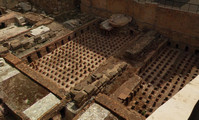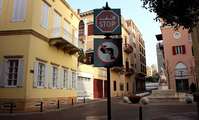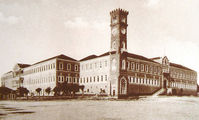terjefossen.com

A BRIEF HISTORY
Before I start writing about aesthetics and architecture in Beirut, I will take a brief historical summation.
Beirut has been populated continuously since 15 century BC, when the city is mentioned in a letter from Tell el Amarna (ancient city on the east side of the River Nile). The city of Beirut was under various empires and control through the ages, for the later time may briefly mention the Kingdom of Jerusalem, Ajjubide dynasty, Mamluk Sultanate, and the Ottoman Empire.
The Ottoman Empire lasted until 1 World War, when it broke down and was divided into mandates through the Sykes-Picot Agreement. The agreement was signed 16 May 1916 between the governments of Britain and France, which Russia agreed. The agreement was kept secret until the Bolsheviks opened tsar archives and published the agreement 23 November 1917. This led to discontent among the Arabs who had been promised an independent Arab state if they revolted against the Ottoman Empire. It was against the Ottoman Empire Thomas Edward Lawrence, better known as Lawrence of Arabia got his fame.
With the defeat of Ottoman Empire advanced the British troops into Syria and Lebanon. French troops arrived Beirut on 8 October 1918 and occupied the coastal region down to Naqoura, the troops replaced the British soldiers. The 21. November 1919 arrived Francois Georges-Picot and the French General Henri Gouraud to Beirut. The French mandate over Lebanon was a fact, similar happened in Syria where the British withdrew from Damascus 26 November 1919.
France got under French mandate responsibility that Lebanon would become independent state in the future. The 26 November 1941, it was announced that Lebanon would become independent under the authority of the Free French government.
French mandate ended in 1943 where Syria and Lebanon became two independent countries and where Beirut was the capital of an independent Lebanon. French troops left Lebanon completely in December 1946. The 22 november 1943, Lebanon's independence was recognized by France.
Lebanon after independence.
Lebanon have after the independence been hit several times by outer and inner conflicts and wars. In 1948, led the Arab-Israeli War to a stream of Palestinian refugees. Over 110000 refugees arrived in Lebanon, but after the hostilities ended Israel did not allow repatriation of the refugees. According to UNRWA, there are now 436154 registered refugees where most live in the 12 refugee camps (January 2012).
In July 1958 the United States intervened at the request of the Lebanese president, to stabilize the acute situation because of strong internal and external political pressure. U.S. troops were in Beirut between 15 July to 25 October 1958. In the 1960s, there was a relatively quiet period with strong growth in the tourism and banking sectors in Beirut and Lebanon.
A new stream of Palestinian refugees arrived Lebanon during and after the 1967 war, this led to a major pro-and anti-Palestinian fractionation in the Lebanese society. The result was a civil war that last for the period 1975 to 1990, with the Israeli invasion in 1982. The period was particularly devastating for infrastructure and society in whole. During the Lebanese civil war was the "Green Line" a demarcation line in Beirut between Muslim factions in West Beirut and Christian factions in East Beirut. A lot of buildings were severely damaged or destroyed along the "Green Line", especially in the Beirut Central District.
Lebanon after 1990.
After the civil war, Lebanon stood over an enormous task of reconstruction and reconciliation.
Prime Minister Rafic Hariri forms Solidere s.a.l. the 5th May 1994, the main task for Solidere is reconstruction and development of Beirut Central District. A major task which is still ongoing today.
Similarly small and large reconstruction projects have been carried out and take place all over Lebanon organized by the Lebanese Council for Development and Reconstruction.
25 May 2000 the Israeli army withdrew out of the occupied South Lebanon, with the exception of Shebaa Farms. IDF's withdrawal resulted in a vacuum that Hezbollah filled. Former Prime Ministe Rafic Hariri was killed 14 februar 2005 with a car bomb, in the wake gathered the Lebanese people in a Cedar Revolution. The result was a Syrian withdrawal from Lebanon and the last Syrian troops left Lebanon 26 April 2005.
The 12 July 2006 broke a war between Israel and Lebanon that lasted for 34 days. One of the main reasons was that Hezbollah took two Israeli soldiers on the border between Israel and Lebanon. The incident led to an Israeli retaliation beyond all proportions where bridges, roads, industry, villages and neighborhoods were bombed. Beirut's Rafik Hariri International Airport runways sustained significant damage, oil tanks at Jiyeh power station was destroyed, which resulted in an environmental disaster about the size of Exxon Valdez accident. Neither the UN or the Red Cross was spared for Israeli attacks.
The war ended with a ceasefire on August 14 after Israel and the Lebanese government had approved UN Resolution 1701 a few days in advance. The war is believed to have killed around 1200, over 4000 wounded and displaced between 750 thousand to one million Lebanese. Because of unexploded Israeli cluster bombs remained some parts of South Lebanon uninhabitable. The reconstruction of Lebanon after the civil war had received a major setback.
Israeli plans to attack Hezbollah was submitted to the Bush administration already in May 2006. This may explain the U.S. passive attitude when the war started and it's destruction. Abduction of two Israeli soldiers were to Israel a golden opportunity to attack Lebanon.
BEIRUT CENTRAL DISTRICT (BCD)
.jpg)
BEIRUT CENTRAL DISTRICT
Coming [...]

ARCHAEOLOGICAL SITES
Coming [...]
BUILDINGS
About some historic buildings in Beirut Central District [...]

STREET LEVEL
Coming [...]
Copyright © 2012-2014. Terje Fossen. All Rights Reserved
